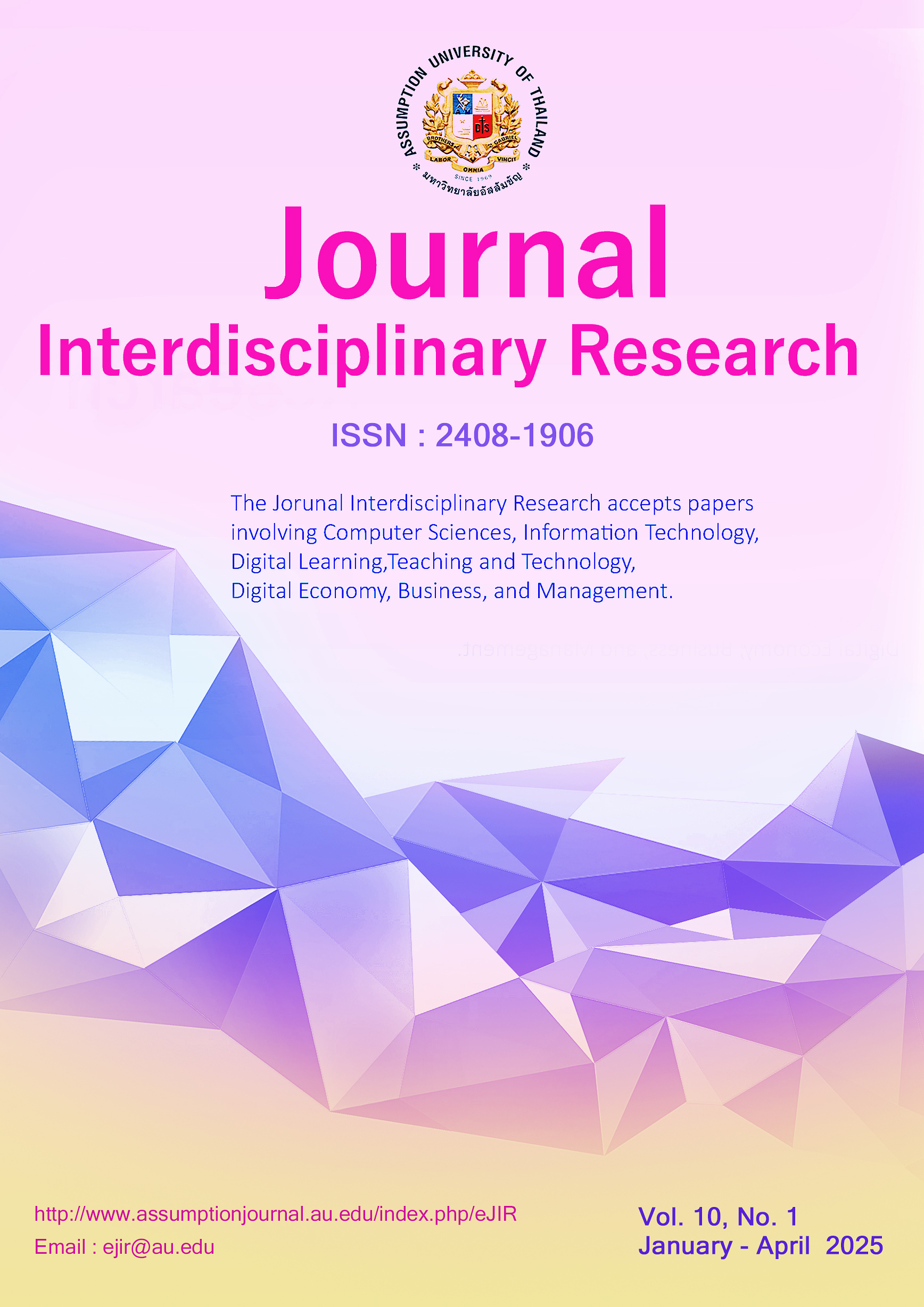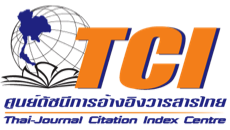Factors Affecting the Resilience of Science and Engineering Students at GXUST in Liuzhou, Guangxi, China
DOI:
https://doi.org/10.14456/au-ejir.2025.6Keywords:
Self-efficacy, Optimism, Self-esteem, Physical Exercise, ResilienceAbstract
Purpose: This study examines the impact of four independent variables—self-efficacy, optimism, self-esteem, and physical exercise—on one dependent variable: resilience. The research aims to identify any statistically significant relationships among these variables. Research design, data and methodology: This study assessed validity using the Index of Item-Objective Congruence (IOC) and reliability through a pilot study with 30 participants (Cronbach's Alpha). A multiple linear regression analysis of 302 valid student responses from Guangxi University of Science and Technology examined relationships among variables. Additionally, a 12-week Intervention Design Implementation (IDI) program with 30 students was evaluated using a paired-sample t-test to compare pre- and post-intervention results. Results: Self-efficacy, optimism, self-esteem, and physical exercise significantly influenced resilience in the regression analysis. The paired-sample t-test showed significant improvements in all variables after the IDI program. Conclusions: This study confirms that self-efficacy, optimism, self-esteem, and physical exercise significantly enhance students' resilience, contributing to existing research on psychological resilience in higher education. The effectiveness of the Intervention Design Implementation (IDI) program highlights practical applications for developing targeted interventions to support student well-being. These findings can inform educational policies and mental health strategies aimed at fostering resilience. Future research should explore long-term effects and cross-cultural variations to enhance resilience-building approaches.
References
Ajzen, I. (1991). The theory of planned behavior. Organizational Behavior and Human Decision Processes, 50(2), 179-211. https://doi.org/10.1016/0749-5978(91)90020-T
American College of Sports Medicine. (1995). Guidelines for exercise testing and prescription (5th ed.). Williams & Wilkins.
Arida, R. M., & Teixeira-Machado, L. (2021). The contribution of physical exercise to brain resilience. Frontiers in Behavioral Neuroscience, 14, 1-18. https://doi.org/10.3389/fnbeh.2020.626769
Arslan, G. (2019). Mediating role of self-esteem and resilience in the association between social exclusion and life satisfaction among adolescents. Personality and Individual Differences, 151, 109514. https://doi.org/10.1016/j.paid.2019.109514
Bandura, A. (1977). Self-efficacy: Toward a unifying theory of behavioral change. Psychological Review, 84(2), 191-215. https://doi.org/10.1037/0033-295X.84.2.191
Bandura, A. (1982). Self-efficacy mechanism in human agency. American Psychologist, 37(2), 122-147. https://doi.org/10.1037/0003-066X.37.2.122
Bandura, A. (1986). Social foundations of thought and action: A social cognitive theory. Prentice-Hall.
Bandura, A. (1997). Self-efficacy: The exercise of control. W.H. Freeman.
Bashir, T., Shafi, S., Ahmed, R. H., Jahangir, S., Saeed, H., & Zaigham, S. (2013). Impact of cognitive and decision-making style on resilience: An exploratory study. European Journal of Business and Management, 5(29), 92-107.
Baumeister, R. F. (1998). The self. In D. T. Gilbert, S. T. Fiske, & G. Lindzey (Eds.), The handbook of social psychology (pp. 680-740). McGraw-Hill.
Boyatzis, R. E. (1982). The competent manager: A model for effective performance. John Wiley & Sons.
Carver, C. S., & Scheier, M. F. (2014). Optimism, human resilience, and the perceived controllability of outcomes. In M. Kent, M. C. Davis, & J. W. Reich (Eds.), The resilience handbook: Approaches to stress and trauma (pp. 243-255). Routledge.
Cloninger, S. C. (1996). Personality: Description, dynamics, and development. W.H. Freeman.
Cohen, J. (1988). Statistical power analysis for the behavioral sciences (2nd ed.). Routledge.
Dumont, M., & Provost, M. A. (1999). Resilience in adolescents: Protective role of social support, coping strategies, self-esteem, and social activities on experiences of stress and depression. Journal of Youth and Adolescence, 28(3), 343-363.
https://doi.org/10.1023/A:1021637011732
Ferguson, L. M. (1996). Preceptors enhance students’ self-confidence. Nursing Connections, 9(1), 49-57.
Fletcher, D., & Sarkar, M. (2013). Psychological resilience: A review and critique of definitions, concepts, and theory. European Psychologist, 18(1), 12-23. https://doi.org/10.1027/1016-9040/a000124
Hair, J. F., Anderson, R. E., Tatham, R. L., & Black, W. C. (1995). Multivariate data analysis. Prentice-Hall.
Hair, J. F., Black, W. C., Babin, B. J., & Anderson, R. E. (2019). Multivariate data analysis (8th ed.). Cengage Learning.
Joseph, J. M. (1994). The resilient child: Preparing today's youth for tomorrow's world. Plenum Press.
Kamtsios, S., & Karagiannopoulou, E. (2015). Exploring relationships between academic hardiness, academic stress, and resilience in school and university students. Educational Psychology, 35(10), 1205-1220.
https://doi.org/10.1080/01443410.2014.893560
Kernis, M. H. (1993). The roles of stability and level of self-esteem in psychological functioning. In R. F. Baumeister (Ed.), Self-esteem: The puzzle of low self-regard (pp. 167-182). Plenum Press.
Li, X., Yu, H., & Yang, N. (2021). The mediating role of resilience in the effects of physical exercise on college students’ negative emotions during the COVID-19 epidemic. Scientific Reports, 11, 24510. https://doi.org/10.1038/s41598-021-04071-1
Liu, Q., Wang, Z., Perera, B. Y., & Lin, S. (2020). Resilience and its associated factors among university students in China: A cross-sectional study. BMC Psychology, 8(1), 79. https://doi.org/10.1186/s40359-020-00453-5
Lubans, D. R., Richards, J., Hillman, C. H., Faulkner, G., Beauchamp, M. R., Nilsson, M., Kelly, P., & Smith, J. J. (2017). Physical activity for cognitive and mental health in youth: A systematic review of mechanisms. Pediatrics, 138(3), e20161642. https://doi.org/10.1542/peds.2016-1642
Luthar, S. S., & Cicchetti, D. (2000). The construct of resilience: Implications for interventions and social policies. Development and Psychopathology, 12(4), 857-885. https://doi.org/10.1017/S0954579400004156
Maslow, A. H. (1943). A theory of human motivation. Psychological Review, 50(4), 370-396. https://doi.org/10.1037/h0054346
Masten, A. S. (2001). Ordinary magic: Resilience processes in development. American Psychologist, 56(3), 227-238.
https://doi.org/10.1037/0003-066X.56.3.227
Mish, F. C. (Ed.). (1996). Merriam-Webster's collegiate dictionary (10th ed.). Merriam-Webster.
Moore, C. G., Carter, R. E., Nietert, P. J., & Stewart, P. W. (2011). Recommendations for planning pilot studies in clinical and translational research. Clinical and Translational Science, 4(5), 332-337. https://doi.org/10.1111/j.1752-8062.2011.00347.x
Nunnally, J. C., & Bernstein, I. H. (1994). The assessment of reliability (3rd ed.). McGraw-Hill.
Orth, U., & Robins, R. W. (2014). The development of self-esteem. Current Directions in Psychological Science, 23(5), 381-387. https://doi.org/10.1177/0963721414547414
Oshio, A., Nakaya, M., Kaneko, H., & Nagamine, S. (2002). Development and validation of an Adolescent Resilience Scale. Japanese Journal of Counseling Science, 35, 57-65.
Peterson, C. (2000). The future of optimism. American Psychologist, 55(1), 44-55. https://doi.org/10.1037/0003-066X.55.1.44
Pritzker, S., & Minter, A. (2014). Measuring and understanding resilience in vulnerable children and youth. The Annals of the American Academy of Political and Social Science, 591(1), 34-46. https://doi.org/10.1177/0002716203262548
Rosenberg, M. (1965). Society and the adolescent self-image. Princeton University Press.
Rosenberg, M., Schooler, C., Schoenbach, C., & Rosenberg, F. (1995). Global self-esteem and specific self-esteem: Different concepts, different outcomes. American Sociological Review, 60(1), 141-156. https://doi.org/10.2307/2096350
Rutter, M. (2006). Implications of resilience concepts for scientific understanding. Annals of the New York Academy of Sciences, 1094(1), 1-12. https://doi.org/10.1196/annals.1376.002
Sabouripour, F., Roslan, S., Ghiami, Z., & Memon, M. A. (2021). Mediating role of self-efficacy in the relationship between optimism, psychological well-being, and resilience among Iranian students. Frontiers in Psychology, 12, 1-11.
https://doi.org/10.3389/fpsyg.2021.675645
Sagone, E., & De Caroli, M. E. (2013). Relationships between resilience, self-efficacy, and thinking styles in Italian middle adolescents. Procedia - Social and Behavioral Sciences, 92, 838-845. https://doi.org/10.1016/j.sbspro.2013.08.762
Santos, M. C., Tavares, D., & De Andrade, A. L. (2018). Optimism and academic resilience in higher education students. Journal of Happiness Studies, 19(7), 2215-2230. https://doi.org/10.1007/s10902-017-9910-4
Scheier, M. F., & Carver, C. S. (1987). Dispositional optimism and physical well-being: The influence of generalized outcome expectancies on health. Journal of Personality, 55(2), 169-210. https://doi.org/10.1111/j.1467-6494.1987.tb00434.x
Schwarzer, R., & Warner, L. M. (2012). Perceived self-efficacy and its relationship to resilience. Springer.
Seligman, M. E. P. (1991). Learned optimism: How to change your mind and your life. Knopf.
Stern, Y., Arenaza-Urquijo, E. M., Bartrés-Faz, D., Belleville, S., Cantilon, M., Chetelat, G., & Park, D. C. (2018). White paper: Defining and investigating cognitive reserve, brain reserve, and brain maintenance. Alzheimer’s & Dementia: The Journal of the Alzheimer’s Association, 16(9), 1305-1311. https://doi.org/10.1016/j.jalz.2018.07.219
Supervía, U. P., Bordás, S. C., & Robres, Q. A. (2022). The mediating role of self-efficacy in the relationship between resilience and academic performance in adolescence. Learning and Motivation, 78. https://doi.org/10.1016/j.lmot.2022.101814
Tiger, L. (1979). Optimism: The biology of hope. Kondansha America.
Tinto, V. (1993). Leaving college: Rethinking the causes and cures of student attrition. University of Chicago Press.
Trzesniewski, K. H., Donnellan, M. B., & Robins, R. W. (2019). Stability and change in self-esteem during adolescence and young adulthood. Journal of Personality and Social Psychology, 116(4), 667-683. https://doi.org/10.1037/pspp0000203
Turner, R. C., & Carlson, L. (2003). Indexes of item-objective congruence for multidimensional items. International Journal of Testing, 3(2), 163-171. https://doi.org/10.1207/S15327574IJT0302_5
Ungar, M. (2008). Resilience across cultures. British Journal of Social Work, 38(2), 218-235. https://doi.org/10.1093/bjsw/bcl343
Whitehead, A. L., Julious, S. A., Cooper, C. L., & Campbell, M. J. (2016). Estimating the sample size for a pilot randomized trial to minimize the overall trial sample size for the external pilot and main trial. Statistical Methods in Medical Research, 25(3), 1057-1073. https://doi.org/10.1177/0962280215588241
Williams, M. H., & Wilkins, L. (1995). Guidelines for exercise testing and prescription (5th ed.). American College of Sports Medicine.
Ying, L., Wu, X., Lin, C., & Jiang, L. (2017). Trajectories of self-efficacy beliefs in Chinese students: Relations with academic resilience and psychological well-being. Learning and Individual Differences, 59, 127-135.
https://doi.org/10.1016/j.lindif.2017.09.006
Yoshikawa, E., Nishi, D., & Matsuoka, Y. J. (2016). Association between regular physical exercise and depressive symptoms mediated through social support and resilience in Japanese company workers: A cross-sectional study. BMC Public Health, 16(1), 3163. https://doi.org/10.1186/s12889-016-3163-8
Downloads
Published
How to Cite
Issue
Section
License
Copyright (c) 2025 Qianjing Pang

This work is licensed under a Creative Commons Attribution 4.0 International License.
A separate Copyright Form will be sent to authors whose paper is accepted for publication.






